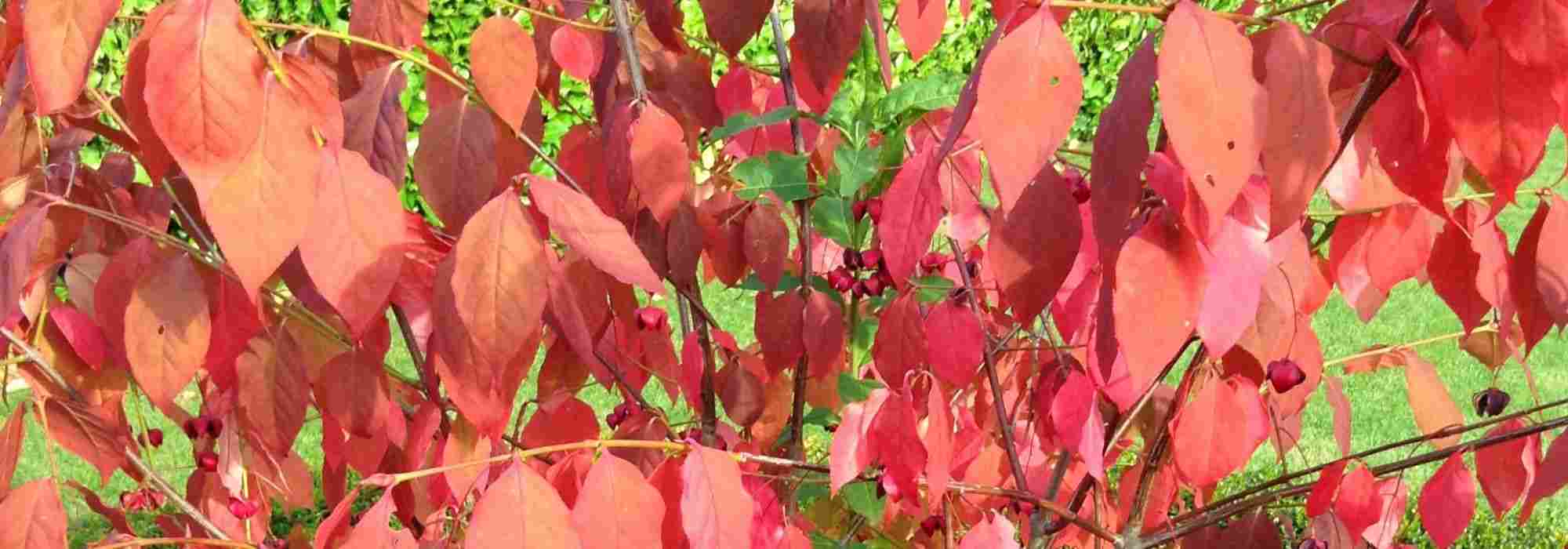
The most beautiful coloured spindle trees in autumn
For a dazzling late season
Contents
Of very easy cultivation and particularly hardy, the spindle trees with deciduous foliage undeniably add a charming touch to the late season. The fruiting and the foliage with beautiful hues make these bushes excellent ornamental subjects. As temperatures drop and days shorten, the leaves reveal various colours: yellow, orange, pink, red, purple, brightening up the garden with warm tones in autumn and winter. Deciduous, they lose their foliage before winter. The seeds of spindle trees provide food for birds: blackbirds, blue tits, or robins, for example. However, a small warning is in order. Very attractive due to their beautiful appearance, the fruits of these bushes are toxic to humans! So, be cautious with children who may be tempted to consume them. On our continent, it is the winged spindle Euonymus alatus and the European spindle Euonymus europaeus that blaze in our parks and gardens, but there are other equally interesting species.
Discover our selection of the most beautiful spindle trees with changing foliage and original, decorative, and vividly coloured fruits!
Euonymus alatus
TheEuonymus alatus is one of the most well-known spindle trees. The cork wings present along its branches have earned it one of its French names: the “winged spindle”. This bush appears rather ordinary in spring and summer with its light green single leaves. But when the end of summer arrives, we witness a stunning colouration of its foliage! The leaves then take on shades of pink, orange, and bright red. It then enters dormancy for winter and gradually loses its leaves. Regarding its flowering, it is discreet, but it gives rise to a uniquely colourful and aesthetic fruiting. The fruit consists of a pink capsule which, when opened, reveals orange and toxic seeds (the orange skin surrounding the seed is called “aril”). This whole structure resembles a “bishop’s hat”, which is why this bush is also referred to as such.
If this spindle tree native to Asia slowly reaches 2 m in all directions, its cultivar Euonymus alatus ‘Compactus’, possessing the same characteristics, only grows to 1 m in height with a diameter of 1.20 m at maturity. Let the winged spindle ignite your garden, whether planted alone or alongside similarly sized bushes in a hedge or at the back of a border.
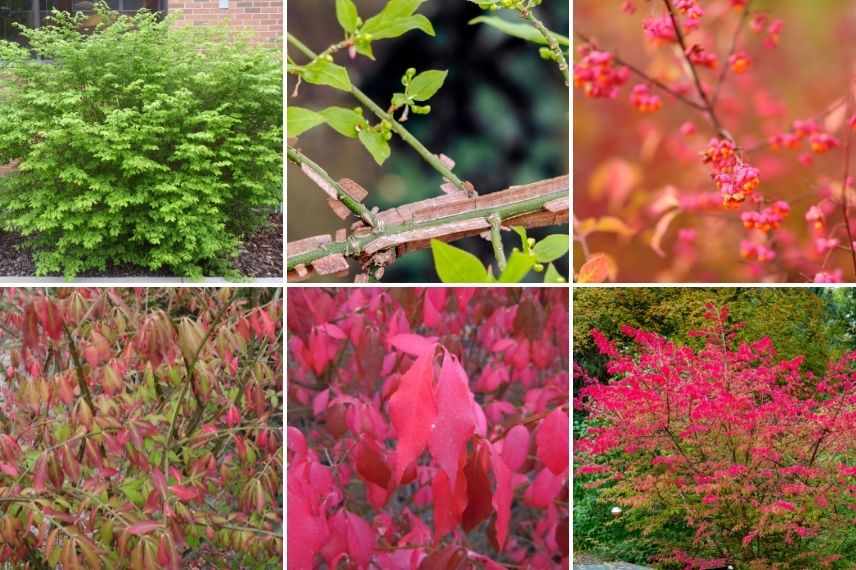
Branches with wings and the various colours of the Euonymus alatus (green leaves on the left and red in the centre – photo Matt Lavin)
Euonymus planipes
Once known as Euonymus planipes, the flat-stemmed spindle tree is now referred to as Euonymus sachalinensis. This bush, originating from the north-east of Asia (Japan, China, and Sakhalin Island), displays spectacular foliage during the autumn season. Initially apple green, the leaves change colour towards the end of August and early September. They turn yellow, slightly orange, and then completely purple. Its fruiting resembles that of the winged spindle tree, but its capsules at the end of long peduncles are larger and redder, almost purple. This species is also distinguished by its branches, which have poorly developed corky wings, and by its buds that are long, pointed, tinged with reddish-brown, and reminiscent of those of beech.
At maturity, Euonymus planipes is slightly larger than its cousin Euonymus alatus and can reach 2.50 m in all directions, sometimes even more. Its silhouette is rather broad and rounded. The flat-stemmed spindle tree has a notable advantage: unlike European spindle trees, it does not suffer from attacks by the spindle moth caterpillar. Although its colours are more vibrant when exposed to full sun, prefer a semi-shaded position if you live in a region of southern France.

Euonymus planipes
Discover other Euonymus - Spindle tree
View all →Available in 3 sizes
Available in 3 sizes
Available in 4 sizes
Available in 2 sizes
Available in 2 sizes
Available in 2 sizes
Available in 1 sizes
Available in 2 sizes
Available in 2 sizes
Available in 2 sizes
Euonymus americanus
Smaller than our European spindle tree, l’Euonymus americanus or American spindle tree has a bushy and flexible habit. This deciduous bush reaches about 1.80 m in all directions and is valued for its elegant and slender trailing branches, as well as its vibrant colours from late summer to autumn. Its leaves are elliptical, sometimes narrow, and are tinged with a light green from spring until the end of August. They then take on a warm, dark reddish-orange hue before falling with the arrival of winter. During autumn, the American spindle tree is adorned with very conspicuous fruits that are crimson red. This fruiting resembles that of the winged spindle and the flat-stemmed spindle, with one difference: the spherical shells containing the bright orange seeds are warty, even spiny. Before they open, they resemble the fruits of the strawberry tree or the wild strawberry. English speakers refer to this species of spindle as the “American Strawberry Bush”.

Euonymus americanus: green foliage (photo James H. Miller & Ted Bodner – Wikimedia), fruits (photo Arlington National Cemetery – Wikimedia), flowers (photo McMasters-Memphis USA – Wikimedia) and bush (photo Amos Oliver Doyle – Wikimedia)
Read also
Spindle: which variety to choose?Euonymus europaeus 'Red Cascade'
Cultivar deciduous from our native European species, Euonymus europaeus ‘Red Cascade’ is a particularly remarkable and ornamental spindle tree. At the end of summer, its fruiting is so abundant that its “bishop’s caps” bend the branches from late summer and throughout much of winter. The numerous pinkish-red fruit husks remain on the bush for a long time, even after the leaves have fallen, allowing the orange winged seeds time to escape. As the first chills arrive, it takes on an intense purple-red colour. This cultivar has been named ‘Red Cascade’ due to its strongly glowing and pendulous leaves. At maturity, this spindle tree reaches 3 m in height and spreads up to 2 m in width. Euonymus ‘Red Cascade’, valued for its natural elegance, can perfectly fit into a bocage hedge.
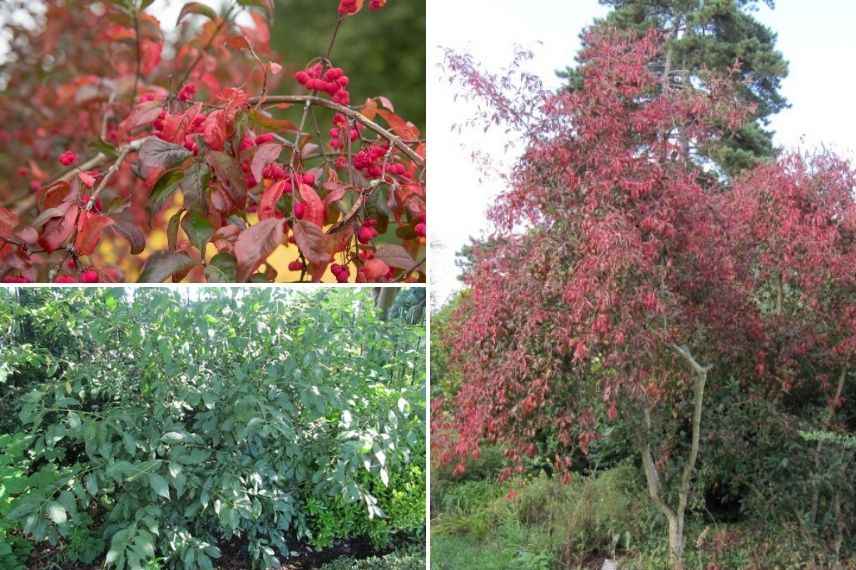
Euonymus europaeus ‘Red Cascade’ (photo green foliage and bush Leonara Enking – Flickr)
Euonymus grandiflorus ‘Red Wine’
Equally splendid in autumn, the Euonymus grandiflorus ‘Red Wine’ is, however, little known. This deciduous spindle tree is sometimes referred to as Euonymus carnosus ‘Red Wine’ or Euonymus atropurpureus var. cheatumi. This bushy and slightly spreading horticultural selection reaches up to 2 m in height and the same in width. Its medium green foliage ignites at the end of August: its leaves inserted on greyish branches turn orange, then intense red, and finally a very dark wine red. Pendulous, the leaves will remain in place for a long time, until December. Its summer flowering will extend from May to July. Its slightly fragrant white flowers are rather large and visible for a spindle tree and attract many insects. In autumn, the bush will bear fruit. Unlike the previously mentioned spindle trees, the capsules of this shrub are cream-yellow, gradually turning pink before releasing the orange winged seeds. Native to Asia, this species is little affected by pests.
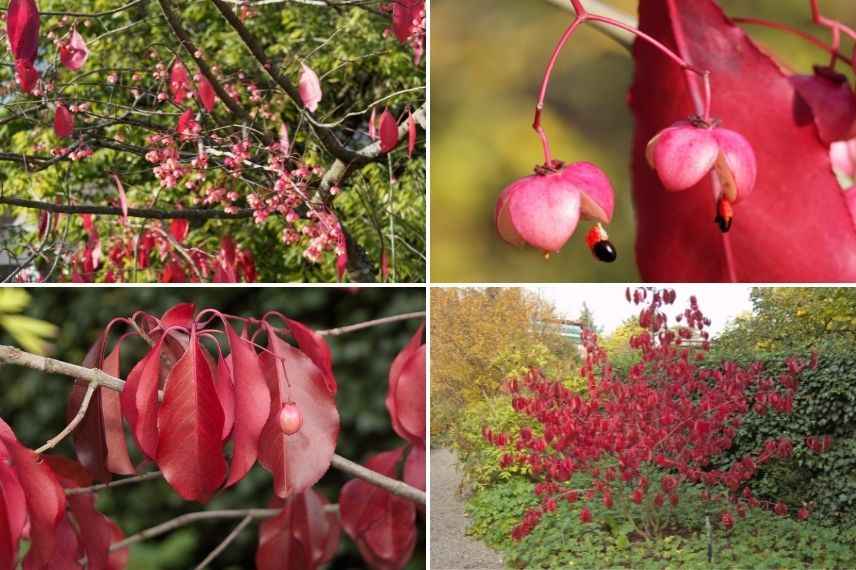
Euonymus grandiflorus ‘Red Wine’ (photos by Ueberwald – Wikimedia)
- Subscribe!
- Contents
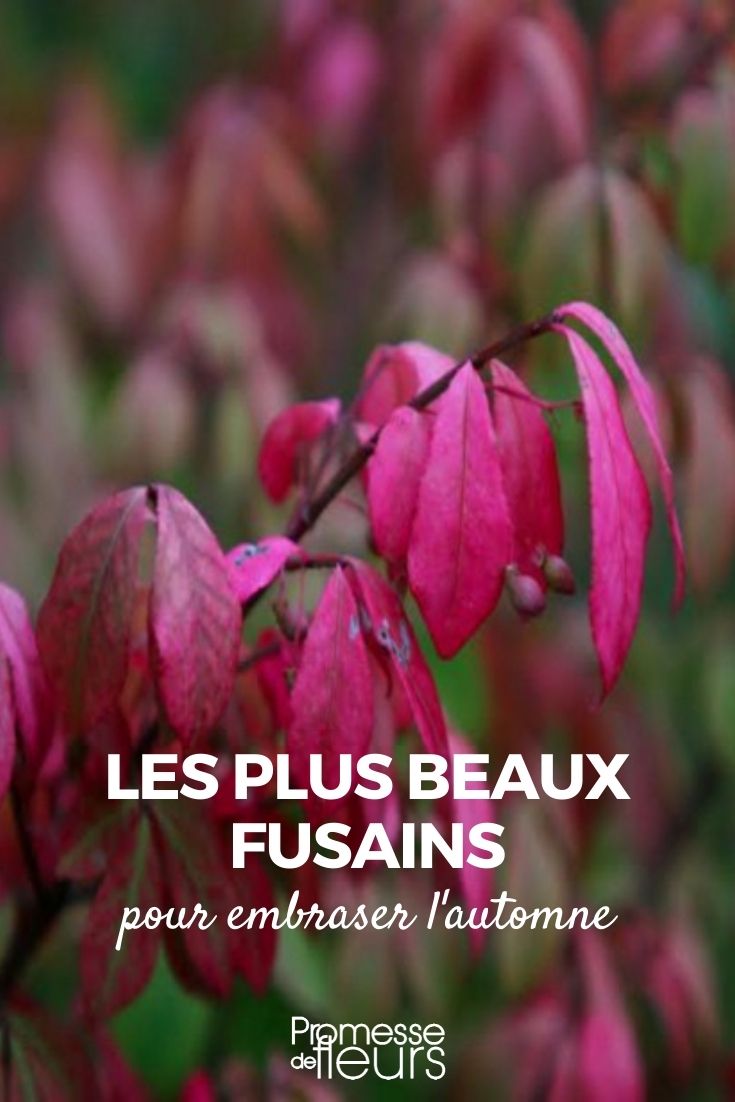
































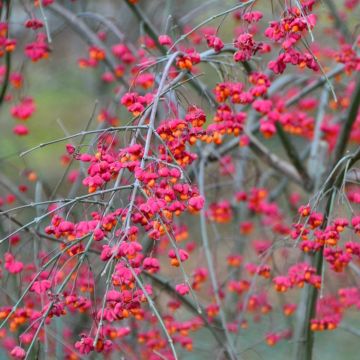



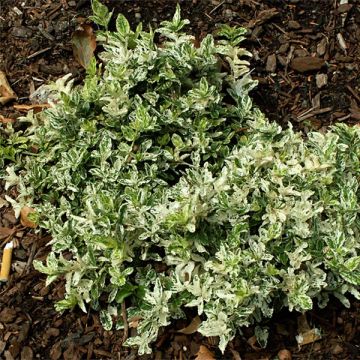
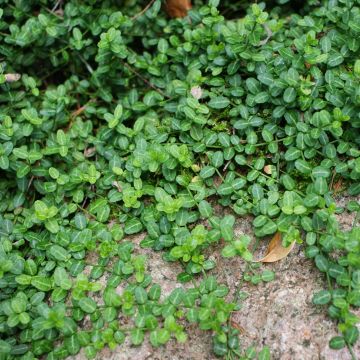



Comments